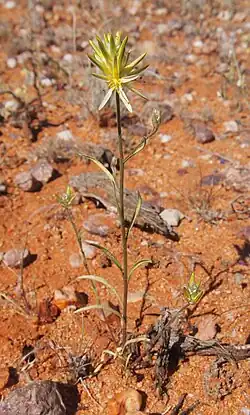Ptilotus gaudichaudii
| Ptilotus gaudichaudii | |
|---|---|

| |
| Scientific classification | |
| Kingdom: | Plantae |
| Clade: | Tracheophytes |
| Clade: | Angiosperms |
| Clade: | Eudicots |
| Order: | Caryophyllales |
| Family: | Amaranthaceae |
| Genus: | Ptilotus |
| Species: | P. gaudichaudii
|
| Binomial name | |
| Ptilotus gaudichaudii | |
| Synonyms[1] | |
| |

Ptilotus gaudichaudii, commonly known as paper foxtail,[2] is a species of flowering plant in the family Amaranthaceae and is endemic to Australia. It is an erect annual herb, with linear leaves and spherical to oval, greenish or yellowish spikes of flowers.
Description
Ptilotus gaudichaudii is an erect or ascending annual herb, that typically grows to a height of up to 50 cm (20 in), its stems and leaves with a sparse covering of simple hairs. Its leaves are sessile or on a short petiole, linear to elliptic or lance-shaped, mostly 15–62 mm (0.59–2.44 in) long and 1–6 mm (0.039–0.236 in) wide. The flowers are arranged in short spherical to oval spikes 10–50 mm (0.39–1.97 in) long and up to 20 mm (0.79 in) wide, with egg-shaped to circular colourless bracts mostly 3–5 mm (0.12–0.20 in) long and bracteoles 3.5–6 mm (0.14–0.24 in) long with a prominent midrib. The outer tepals are 11–14 mm (0.43–0.55 in) long and the inner tepals 10.7–13.5 mm (0.42–0.53 in) long. There are 3 stamens and 2 staminodes, the style is 8–10 mm (0.31–0.39 in) long and straight, fixed to the side of the ovary. Flowering occurs from April to October.[2][3][4][5]
Taxonomy
This species was first formally described in 1841 by von Steude who gave it the name Trichinium gaudichaudii in Nomenclator Botanicus.[6] In 1945, John Black transferred the species to Ptilotus as P. gaudichaudii in Transactions of the Royal Society of South Australia. The specific epithet (gaudichaudii) honours Charles Gaudichaud-Beaupré.[7]
Distribution and habitat
Ptilotus gaudichaudii grows on sand, loam or clay and is widespread in Western Australia,[5] South Australia,[8] the Northern Territory,[4] Queensland[1] and a few places in the far west of New South Wales.[2]
See also
References
- ^ a b c "Ptilotus gaudichaudii". Australian Plant Census. Retrieved 16 July 2025.
- ^ a b c "Ptilotus gaudichaudii". Royal Botanic Garden, Sydney. Retrieved 16 July 2025.
- ^ Lally, Terena R.; Barker, William R. (2010). "Taxonomic notes on South Australian Ptilotus (Amaranthaceae)". Journal of the Adelaide Botanic Gardens. 24: 47–48. Retrieved 17 July 2025.
- ^ a b "Ptilotus gaudichaudii". Northern Territory Government. Retrieved 16 July 2025.
- ^ a b "Ptilotus gaudichaudii". FloraBase. Western Australian Government Department of Biodiversity, Conservation and Attractions.
- ^ "Trichinium gaudichaudii". Australian Plant Name Index. Retrieved 17 July 2025.
- ^ George, Alex S.; Sharr, Francis A. (2023). Western Australian Plant Names and Their Meanings - A Glossary (fifth ed.). Kardinya: Four Gables Press. p. 208. ISBN 9780645629538.
- ^ "Ptilotus gaudichaudii ssp. gaudichaudii". Seeds of South Australia. Retrieved 17 July 2025.